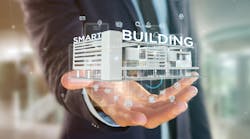How to Design and Install Smart Building Power Solutions
If you’re an electrician tasked with handling the specifics for smart building power, succeeding in the design and installation requires having an all-encompassing perspective of needs. Here are some useful tips to keep in mind.
Discuss the client’s current and future requirements
An excellent electrical design for a smart building accommodates the current needs and anticipated future requirements. Take the time to learn about the clients’ must-have features and how they expect the structure to function.
Help your clients think of possibilities they may not have considered. If employees enter the building with electronic keys, you might link the key system and lighting. That way, someone could walk into an illuminated room rather than fumble around for the wall switches.
You might also suggest how power solutions can support people’s productivity, such as by automatically adjusting lighting levels to reduce glare. Let your clients know what options exist. That will help them make informed decisions about what they want regarding the smart building’s power and give them accurate expectations.
Let natural light guide some design decisions
Many smart building power systems respond to people, such as when they walk into or leave rooms. However, the design can also react to sunlight. Considering that option is especially wise if the structure already has large windows to take advantage of natural light.
For example, when bright sunlight streams through Dallas-Fort Worth Airport’s windows, sensors dim the lights. However, the lights change again if a cloud blocks sunlight. There’s a similar setup at an engineering building at the University of Pennsylvania campus. It features smart blinds that react to the sun’s path.
Assess how any smart building power solutions you use could work with natural light rather than against it. Taking that approach could help save energy, and it shows forethought.
Strive for streamlined operations
Smart building power options open opportunities to design lighting and other components that offer multitasking functionality. Some cities have streetlights that double as Wi-Fi connection points. You might install a system that handles both the building’s climate controls and lights. That way, the client only has to learn to operate one new thing.
Investigate options that let people control lighting from an app or a centralized panel, so the system is as user-friendly as possible. Help clients feel excited about what they can look forward to once the power solutions are installed. One plastics company saved more than $50,000 in annual power costs by upgrading the lighting system. Providing such examples can help them feel they’re justified in making the investments.
Smart building power systems have three layers that work together. Management controls the setup from a centralized point. It also collects incoming data and can detect and correct problems as a result. The control layer concerns the smart building’s hardware. Finally, the field includes the sensors and actuators that gather data, perform tasks, and make adjustments. These devices typically work on DC power in the 5V to 24V range of batteries.
Ideally, the person operating the system would never think about these multiple layers. The interface they use should be so straightforward that they have seamless experiences. Understanding how the three layers work and what they contain is crucial for highly functional electrical design.
Conquer challenges with a smart building consultant or installer
Consultants or installers specializing in smart building power will have specific advice for dealing with obstacles related to devices, integrations, and other areas of concern. A smart building consultant usually assists with the design and construction phases of a project. They can also help the owner or manager unlock new potential from existing data streams.
The consultant or installer will also know to provide an estimated timeframe for the installation. Perhaps the building is in constant use or is currently in its busiest period. If so, one of the installation-related challenges could involve choosing the best time for it. Should it happen all at once or in stages? If the design requires significant retrofitting, the installation will take longer than if the building were ready for the new technologies.
The specialist can also advise on any general pitfalls and how to avoid them. They can also recommend how many people to hire to complete the installation and provide details about associated warranties.
Keep everyone on the same page during the installation
The smart building power system will likely integrate with products outside of what you typically deal with as an electrician. Consider a case where the same system handles the building’s lights, locks, and HVAC. In that case, you’d need to have ongoing engagement with the teams overseeing the security and climate control portions of a smart building revamp.
Assess any instances where the building will have integrated components. Then, make sure everyone involved with those aspects understands their role in making the various technologies in the smart building work together smoothly.
Consider using a project management app to facilitate hassle-free communication between the various contracting companies and teams. That way, everyone can get up-to-date and relevant information that could affect what they’re working on, whether it relates to the electrical installation or something else.
A thoughtful approach leads to successful outcomes
As these tips suggest, getting good results with your smart building power choices starts by understanding all the aspects that could influence how things turn out. Focusing only on the matters that directly involve electrical decisions or your team of electricians is too short-sighted and could delay the project or make it go over budget.
Emily Newton is the editor-in-chief of Revolutionized. She has over five years of experience showing how technology is changing the construction and manufacturing industries. She can be reached at https://emilyjnewton.com/.



